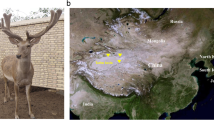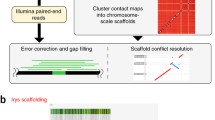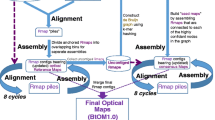Abstract
We present here the de novo genome assembly CerEla1.0 for the red deer, Cervus elaphus, an emblematic member of the natural megafauna of the Northern Hemisphere. Humans spread the species in the South. Today, the red deer is also a farm-bred animal and is becoming a model animal in biomedical and population studies. Stag DNA was sequenced at 74× coverage by Illumina technology. The ALLPATHS-LG assembly of the reads resulted in 34.7 × 103 scaffolds, 26.1 × 103 of which were utilized in Cer.Ela1.0. The assembly spans 3.4 Gbp. For building the red deer pseudochromosomes, a pre-established genetic map was used for main anchor points. A nearly complete co-linearity was found between the mapmarker sequences of the deer genetic map and the order and orientation of the orthologous sequences in the syntenic bovine regions. Syntenies were also conserved at the in-scaffold level. The cM distances corresponded to 1.34 Mbp uniformly along the deer genome. Chromosomal rearrangements between deer and cattle were demonstrated. 2.8 × 106 SNPs, 365 × 103 indels and 19368 protein-coding genes were identified in CerEla1.0, along with positions for centromerons. CerEla1.0 demonstrates the utilization of dual references, i.e., when a target genome (here C. elaphus) already has a pre-established genetic map, and is combined with the well-established whole genome sequence of a closely related species (here Bos taurus). Genome-wide association studies (GWAS) that CerEla1.0 (NCBI, MKHE00000000) could serve for are discussed.






Similar content being viewed by others
References
Altschul SF, Gish W, Miller W, Myers EW, Lipman DJ (1990) Basic local alignment search tool. J Mol Biol 215(3):403–410. https://doi.org/10.1016/S0022-2836(05)80360-2
Arias J, Keehan M, Fisher P, Coppieters W, Spelman R (2009) A high density linkage map of the bovine genome. BMC Genet 10(1):18. https://doi.org/10.1186/1471-2156-10-18
Ba H, Wang D, Li C (2016) MicroRNA profiling of antler stem cells in potentiated and dormant states and their potential roles in antler regeneration. Mol Genet Genom 291:943–955. https://doi.org/10.1007/s00438-015-1158-8
Balla B, Kósa J, Kiss J, Borsy A, Podani J, Takács I, Lazáry Á, Nagy Z, Bácsi K, Speer G, Orosz L, Lakatos P (2008) Different gene expression patterns in the bone tissue of aging postmenopausal osteoporotic women. Calcif Tissue Int 82(1):12–26. https://doi.org/10.1007/s00223-007-9092-3
Bán I (1998) The Hungarian wonder deer. EP Systema, Debrecen (ISBN:963-03-4955-8)
Barta E, Bánfalvi Z, Havelda Z, Hiripi L, Jeney Z, Kiss J, Kolics B, Marincs F, Silhavy D, Stéger V, Várallyay É (2016) Agricultural genomics: an overview of the next generation sequencing projects at the NARIC-Agricultural Biotechnology Institute in Gödöllő. Hung Agric Res 25:10–21
Biedrzycka A, Solarz W, Okarma H (2012) Hybridization between native and introduced species of deer in Eastern Europe. J Mammal 93(5):1331–1341. https://doi.org/10.1644/11-MAMM-A-022.1
Bonnet A, Thévenon S, Claro F, Gautier M, Hayes H (2001) Cytogenetic comparison between Vietnamese sika deer and cattle: R-banded karyotypes and FISH mapping. Chromosome Res 9:673–687. https://doi.org/10.1023/A:1012908508488
Borsy A, Podani J, Stéger V, Balla B, Horváth A, Kósa J, Gyurján I, Molnár A, Szabolcsi Z, Szabó L, Jakó E, Zomborszky Z, Nagy J, Semsey S, Vellai T, Lakatos P, Orosz L (2009) Identifying novel genes involved in both deer physiological and human pathological osteoporosis. Mol Genet Genom 281:301–313. https://doi.org/10.1007/s00438-008-0413-7
Brauning R, Fisher PJ, McCulloch AF, Smithies RJ, Ward JF, Bixley MJ, Lawley CT, Rowe SJ, McEwan JC (2015) Utilization of high throughput genome sequencing technology for large scale single nucleotide polymorphism discovery in red deer and Canadian elk. bioRxiv. https://doi.org/10.1101/027318
Campbell MS, Holt C, Moore B, Yandell M (2014) Genome annotation and curation using MAKER and MAKER-P. Curr Protoc Bioinform 48:4.11.1–4.11.39. https://doi.org/10.1002/0471250953.bi0411s48
Cantarel BL, Korf I, Robb SM, Parra G, Ross E, Moore B, Holt C, Sánchez Alvarado A, Yandell M. (2008) MAKER: an easy-to-use annotation pipeline designed for emerging model organism genomes. Genome Res 18(1):188–196. https://doi.org/10.1101/gr.6743907
Everts-van der Wind A, Kata SR, Band MR, Rebeiz M, Larkin DM, Everts RE, Green CA, Liu L, Natarjan S, Goldammer T, Lee JH, McKay S, Womack JE, Lewin HA (2004) A 1463 gene cattle–human comparative map with anchor points defined by human genome sequence coordinates. Genome Res 14(7):1424–1437. https://doi.org/10.1101/gr.2554404
Everts-van der Wind A, Larkin DM, Green CA, Elliott JS, Olmstead CA, Chiu R, Schein JE, Marra MA, Womack JE, Lewin HA (2005) A high-resolution whole-genome cattle–human comparative map reveals details of mammalian chromosome evolution. Proc Natl Acad Sci USA 102(51):18526–18531. https://doi.org/10.1073/pnas.0509285102
Fisher PJ, Brauning R, McCulloch AF, Smithies RJ, Ward JF, Bixley MJ, Lawley CT, Everett-Hincks JM, McEwan JC (2015) Utilization of high throughput genome sequencing technology for large scale single nucleotide polymorphism discovery in red deer and Canadian elk. bioRxiv. https://doi.org/10.1101/027318
Fontana F, Rubini M (1990) Chromosomal evolution in Cervidae. Biosystems 24(2):157–174. https://doi.org/10.1016/0303-2647(90)90008-O
Frank K, Barta E, Bana N, Nagy J, Horn P, Orosz L, Stéger V (2016) Complete mitochondrial genome sequence of a Hungarian red deer (Cervus elaphus hippelaphus) from high-throughput sequencing data and its phylogenetic position within the family Cervidae. Acta Biol Hung 67:133–147. https://doi.org/10.1556/018.67.2016.2.2
Frank K, Bleier N, Tóth B, Sugár L, Horn P, Barta E, Orosz L, Stéger V (2017) The presence of Balkan and Iberian red deer (Cervus elaphus) mitochondrial DNA lineages in the Carpathian Basin. Mammal Biol 86:48–55. https://doi.org/10.1016/j.mambio.2017.04.005
Gnerre S, Maccallum I, Przybylski D, Ribeiro FJ, Burton JN, Walker BJ, Sharpe T, Hall G, Shea TP, Sykes S, Berlin AM, Aird D, Costello M, Daza R, Williams L, Nicol R, Gnirke A, Nusbaum C, Lander ES, Jaffe DB (2011) High-quality draft assemblies of mammalian genomes from massively parallel sequence data. Proc Natl Acad Sci USA 108(4):1513–1518. https://doi.org/10.1073/pnas.1017351108
Grabherr MG, Haas BJ, Yassour M, Levin JZ, Thompson DA, Amit I, Adiconis X, Fan L, Raychowdhury R, Zeng Q, Chen Z, Mauceli E, Hacohen N, Gnirke A, Rhind N, di Palma F, Birren BW, Nusbaum C, Lindblad-Toh K, Friedman N, Regev A (2011) Full-length transcriptome assembly from RNA-Seq data without a reference genome. Nat Biotechnol 29:644–652. https://doi.org/10.1038/nbt.1883
Gu L, Mo E, Zhu X, Jia X, Fang Z, Sun B et al (2008) Analysis of gene expression in four parts of the red deer antler using DNA chip microarray technology. Anim Biol 58:67–90. https://doi.org/10.1163/157075608X303654
Gustavsson I, Sundt CO (1968) Karyotypes in five species of deer (Alces alces L., Capreolus capreolus L., Cervus elaphus L., Cervus nippon nippon Temm. and Dama dama L.). Hereditas 60:233–248. https://doi.org/10.1111/j.1601-5223.1968.tb02204.x
Gyurján I, Molnár A, Borsy A, Stéger V, Hackler L, Zomborszky Z, Papp P, Duda E, Deák F, Lakatos P, Puskás LG, Orosz L (2007) Gene expression dynamics in deer antler: mesenchymal differentiation toward chondrogenesis. Mol Genet Genom 277:221–235. https://doi.org/10.1007/s00438-006-0190-0
Haldane JBS (1919) The combination of linkage values, and the calculation of distance between linked factors. J Genet 8:299–309
Harris RS (2007) Improved pairwise alignment of genomic DNA. Ph.D. Thesis, The Pennsylvania State University
Jia BY, Ba HX, Wang GW, Yang Y, Cui XZ, Peng YH, Zheng JJ, Xing XM, Yang FH (2016) Transcriptome analysis of sika deer in China. Mol Genet Genom 291:1941–1953. https://doi.org/10.1007/s00438-016-1231-y
Johnston SE, Huisman J, Ellis PA, Pemberton JM (2017) Sexual dimorphism in recombination landscape in red deer (Cervus elaphus): a role for meiotic drive? bioRxiv. https://doi.org/10.1101/100131
Jones P, Binns D, Chang HY, Fraser M, Li W, McAnulla C, McWilliam H, Maslen J, Mitchell A, Nuka G, Pesseat S, Quinn AF, Sangrador-Vegas A, Scheremetjew M, Yong SY, Lopez R, Hunter S (2014) InterProScan 5: genome-scale protein function classification. Bioinformatics 30(9):1236–1240. https://doi.org/10.1093/bioinformatics/btu031
Kierdorf U, Li C, Price JS (2009) Improbable appendages: Deer antler renewal as a unique case of mammalian regeneration. Sem Cell Dev Biol 20:535–542. https://doi.org/10.1016/j.semcdb.2008.11.011
Korf I (2004) Gene finding in novel genomes. BMC Bioinform 5:59. https://doi.org/10.1186/1471-2105-5-59
Korf I, Yandell M, Bedell J (2003) An essential guide to the basic local alignment search tool: BLAST. O’Reilly & Associates, Inc., Sebastopol
Kosambi DD (1943) The estimation of map distance from recombination values. Ann Eugen 12:172–175. https://doi.org/10.1111/j.1469-1809.1943.tb02321.x
Kozomara A, Griffiths-Jones S (2014) miRBase: annotating high confidence microRNAs using deep sequencing data. Nucleic Acids Res 42:D68–D73. https://doi.org/10.1093/nar/gkt1181
Kurtz S, Phillippy A, Delcher AL, Smoot M, Shumway M, Antonescu C, Salzberg SL (2004) Versatile and open software for comparing large genomes. Genome Biol 5(2):R12. https://doi.org/10.1186/gb-2004-5-2-r12
Li H, Durbin R (2009) Fast and accurate short read alignment with Burrows–Wheeler transform. Bioinformatics 25:1754–1760. https://doi.org/10.1093/bioinformatics/btp324
Li C, Suttie JM (2001) Deer antlerogenic periosteum: a piece of postnatally retained embryonic tissue? Anat Embryol 204:375–388. https://doi.org/10.1007/s004290100204
Li C, Suttie JM (2012) Morphogenetic aspects of deer antler development. Front Biosci 4:1836–1842. https://doi.org/10.2741/e505
Li C, Clark DE, Lord EA, Stanton JA, Suttie JM (2002) Sampling technique to discriminate the different tissue layers of growing antler tips for gene discovery. Anat Rec 268:125–130. https://doi.org/10.1002/ar.10120
Li C, Stanton JL, Robertson TM, Suttie JM, Sheard PW, Harris JA, Clark DE (2007) Nerve growth factor mRNA expression in the regenerating antler tip of Red Deer (Cervus elaphus). PLoS One 10(2):e148. https://doi.org/10.1371/journal.pone.0000148
Li H, Handsaker B, Wysoker A, Fennell T, Ruan J, Homer N, Marth G, Abecasis G, Durbin R, 1000 Genome Project Data Processing Subgroup (2009) The sequence alignment/map (SAM) format and SAMtools. Bioinformatics 25:2078–2079. https://doi.org/10.1093/bioinformatics/btp352
Ma RZ, Beever JE, Da Y, Green CA, Russ I, Park C, Heyen DW, Everts RE, Fisher SR, Overton KM, Teale AJ, Kemp SJ, Hines HC, Guérin G, Lewin HA (1996) A male linkage map of the cattle (Bos taurus) genome. J Hered 4:261–271. https://doi.org/10.1093/oxfordjournals.jhered.a022999
McDevitt AD, Edwards CJ, O’Toole P, O’sullivan P, O’Reilly C, Carden RF (2009) Genetic structure of, and hybridisation between, red (Cervus elaphus) and sika (Cervus nippon) deer in Ireland. Mammal Biol 74:263–273. https://doi.org/10.1016/j.mambio.2009.03.015
Molnár A, Gyurján I Jr, Korpos E, Borsy A, Stéger V, Buzás Z, Kiss I, Zomborszky Z, Papp P, Deák F, Orosz L (2007) Identification of differentially expressed genes in the developing antler of red deer Cervus elaphus. Mol Genet Genom 277:237–248. https://doi.org/10.1007/s00438-006-0193-x
Molnár J, Nagy T, Stéger V, Tóth G, Marincs F, Barta E (2014) Genome sequencing and analysis of Mangalica, a fatty local pig of Hungary. BMC Genom 15:761. https://doi.org/10.1186/1471-2164-15-761
Park HJ, Lee DH, Park SG, Lee SC, Cho S, Kim HK et al (2004) Proteome analysis of red deer antlers. Proteomics 11:3642–3653. https://doi.org/10.1002/pmic.200401027
Price J, Allen S (2004) Exploring the mechanisms regulating regeneration of deer antlers. Philos Trans R Soc Lond Biol 359:809–822. https://doi.org/10.1098/rstb.2004.1471
Price J, Allen S, Faucheux C, Althanaian T, Mount J (2005) Deer antlers: a zoological curiosity or the key to understanding organ regeneration in mammals? J Anat 207:603–618. https://doi.org/10.1111/j.1469-7580.2005.00478.x
Quast C, Pruesse E, Yilmaz P, Gerken J, Schweer T, Yarza P, Peplies J, Glöckner FO (2013) The SILVA ribosomal RNA gene database project: improved data processing and web-based tools. Nucleic Acids Res 41:D590–D596. https://doi.org/10.1093/nar/gks1219
Rice P, Longden I, Bleasby A (2000) EMBOSS: the European molecular biology open software suite. Trends Genet 16(6):276–277. https://doi.org/10.1016/S0168-9525(00)02024-2
Schattner P, Brooks AN, Lowe TM (2005) The tRNAscan-SE, snoscan and snoGPS web servers for the detection of tRNAs and snoRNAs. Nucleic Acids Res 33:W686–W689. https://doi.org/10.1093/nar/gki366
Slate J, Van Stijn TC, Anderson RM, McEwan KM, Maqbool NJ, Mathias HC, Bixley MJ, Stevens DR, Molenaar AJ, Beever JE, Galloway SM, Tate ML (2002a) A deer (subfamily Cervinae) genetic linkage map and the evolution of ruminant genomes. Genetics 160:1587–1597
Slate J, Visscher PM, MacGregor S, Stevens D, Tate ML, Pemberton JM (2002b) A genome scan for quantitative trait loci in a wild population of red deer (Cervus elaphus). Genetics 162:1863–1873
Smit AFA, Hubley R, Green P (2013–2015) RepeatMasker Open-4.0. http://www.repeatmasker.org/. Accessed Jan 2016
Stanke M, Tzvetkova A, Morgenstern B (2006) AUGUSTUS at EGASP: using EST, protein and genomic alignments for improved gene prediction in the human genome. Genome Biol 7:S11–S18. https://doi.org/10.1186/gb-2006-7-s1-s11
Stéger V, Molnár A, Borsy A, Gyurján I, Szabolcsi Z, Dancs G, Molnár J, Papp P, Nagy J, Puskás L, Barta E, Zomborszky Z, Horn P, Podani J, Semsey S, Lakatos P, Orosz L (2010) Antler development and coupled osteoporosis in the skeleton of red deer Cervus elaphus: expression dynamics for regulatory and effector genes. Mol Genet Genom 284:273–287. https://doi.org/10.1007/s00438-010-0565-0
Szabolcsi Z, Egyed B, Zenke P, Padar Z, Borsy A, Steger V, Pasztor E, Csanyi S, Buzas Z, Orosz L (2014) Constructing STR multiplexes for individual identification of Hungarian red deer. J Forensic Sci 59:1090–1099. https://doi.org/10.1111/1556-4029.12403
Tate ML, Mathias HC, Fennessy PF, Dodds KG, Penty JM, Hill DF (1995) A new gene mapping resource: interspecies hybrids between Père David’s deer (Elaphurus davidianus) and red deer (Cervus elaphus). Genetics 139:1383–1391
Wang K, Li M, Hakonarson H (2010) ANNOVAR: functional annotation of genetic variants from next-generation sequencing data. Nucleic Acids Res 38:e164. https://doi.org/10.1093/nar/gkq603
Yao B, Zhao Y, Zhang H, Zhang M, Liu M, Liu H, Li J (2012) Sequencing and de novo analysis of the Chinese Sika deer antler-tip transcriptome during the ossification stage using Illumina RNA-Seq technology. Biotechnol Lett 34:813–822. https://doi.org/10.1007/s10529-011-0841-z
Acknowledgements
This work was supported by the Doctoral School of Animal Science of the Kaposvár University; by the Ministry of Agriculture, Grant No. NAIK–MBK/M71411; by the Ministry of Health, Social and Family Affairs, Grant ETT–ESKI 006/2009; by the Hungarian Academy of Sciences, Grant No. E-127/9/1/2012; by NKFP, Grant 1A/007/2004. We acknowledge NIIF for awarding us access to resources based in Hungary at Pécs, Szeged and Debrecen.
Funding
This work was supported by the Ministry of Agriculture, Grant No. NAIK–MBK/M71411; by the Ministry of Health, Social and Family Affairs, Grant ETT–ESKI 006/2009; by the Hungarian Academy of Sciences, Grant No. E-127/9/1/2012; and by NKFP, Grant 1A/007/2004.
Author information
Authors and Affiliations
Contributions
NÁB (bioinformatics), KF (molecular genetics), JN (deer breeding) PhD students of Kaposvár University, AN (bioinformatics), TN (bioinformatics), MS (bioinformatics) research assistants of NARIC, VS (molecular genetics and genomics) supervised the laboratory work, PL (medical research, non-model animals), LS (veterinarian zoology) organized the collection of samples, EB supervised bioinformatics, PH animal geneticist, led the Doctoral School of Animal Science of the Kaposvár University, LO designed the study, analysed the data and wrote the paper. All authors contributed to revisions. Results are available online at emboss.abc.hu/wonderdeer/Jbrowse.
Corresponding author
Ethics declarations
Conflict of interest
The authors declare that they have no conflict of interest.
Ethical approval
All applicable international, national, and/or institutional guidelines for the care and use of animals were followed. Blood was collected from a living animal performed by a trained veterinarian according to the standard veterinary medical practice with a permission from the Hungarian Veterinary Chamber. Sample collection was performed by a trained veterinarian according to standard veterinary medical practice with a permission from the Hungarian Veterinary Chamber [Hungarian Animal Rights Law (243/1998, XII.31)].
Additional information
Communicated by S. Hohmann.
Electronic supplementary material
Below is the link to the electronic supplementary material.
Fig. S1
Acrocentric deer chromosome Ce15 is split to two acrocentric bovine chromosomes Bt28 and Bt26. Black dots correspond to centromerons. (TIF 64 KB)
Fig. S2
Tandem fusion of acrocentric deer chromosomes Ce28 and Ce26 in cattle acrocentric chromosome Bt9. Note, the large paracentric inversion in Ce28 overlaps the entire chromosomal segment between map markers ETH225 and CGA/OarCP021. Black dots correspond to centromerons. (TIF 151 KB)
Fig. S3
Tandem fusion of acrocentric deer chromosomes Ce3 and Ce22 in acrocentric bovine chromosome Bt5. Black dots correspond to centromerons. (TIF 108 KB)
Table S1
ALLPATH-LG report on CerEla1.0 assembly (XLSX 11 KB)
Table S2
Position (in cM and in Mbp) of the genetic map markers used along the C. elaphus linkage groups/chromosomes. The genetic map markers are aligned as is published in Slate et al. 2002a; *, centromeron–proximal marker. (XLSX 22 KB)
Table S3
Physical position (in Mbp) of the terminal genetic map markers on the C. elaphus linkage groups/chromosomes. The genetic map markers are aligned as is published in Slate et al. 2002a ; *, centromeron–proximal mapmarker. (XLSX 18 KB)
Rights and permissions
About this article
Cite this article
Bana, N.Á., Nyiri, A., Nagy, J. et al. The red deer Cervus elaphus genome CerEla1.0: sequencing, annotating, genes, and chromosomes. Mol Genet Genomics 293, 665–684 (2018). https://doi.org/10.1007/s00438-017-1412-3
Received:
Accepted:
Published:
Issue Date:
DOI: https://doi.org/10.1007/s00438-017-1412-3




